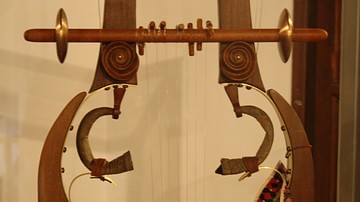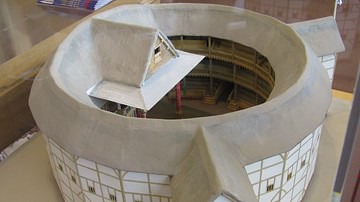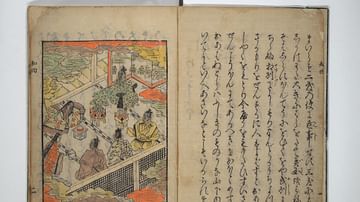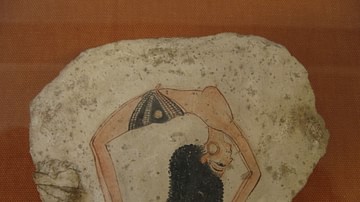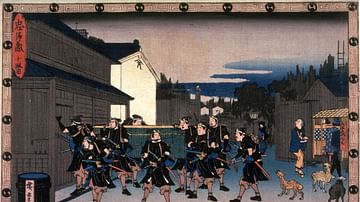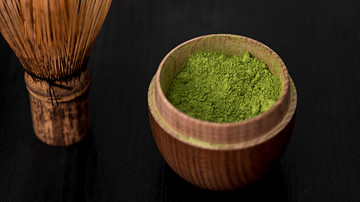Video
Ningyo Joruri is a combination of ningyo (puppets) and Joruri (narrative music) which combines voice and shamisen. It is now known as “Bunraku” since that is now the main troupe that represents this art form. It is a comprehensive performance art created in the Edo period (1603 – 1868) by combining three art forms that each have long, but separate histories: narrative singing performed by the tayu, instrumental musicians playing the three-stringed shamisen and puppeteers.
Usually, a solo tayu plays all the roles and expresses the speech, emotions and movements of all different kinds of characters using a wide range of tones and voices and describes the scene with a combination of speech and song. His performance is punctuated by the music of the shamisen player who plays a futozao (“thick-necked”) shamisen which is very large and can produce a rich variety of sounds, from loud and powerful to quiet and delicate. Like a conductor, the shamisen player guides the speed and pacing of the performance. The puppets used in Bunraku for major roles are very large and have three puppeteers, which allows for very detailed and sensitive movement, but requires very precise coordination of the three puppeteers.
We will explore Bunraku with the help of three performers, each representing one of the three parts of this puppet theatre.
Presented by: The Japan Foundation (JF) (https://www.jpf.go.jp/e/)
<Program Credits>
Performers: TAKEMOTO Oritayu Ⅵ, TSURUSAWA Seisuke, KIRITAKE Kanjuro III, YOSHIDA Minoshiro, KIRITAKE Kansuke, KIRITAKE Kansho, KIRITAKE Kanjiro, MOCHIZUKI Tamekichi
In cooperation with: Japan Arts Council National Bunraku Theatre, BUNRAKU KYOKAI, The Bunraku-za Company, Wakayama Film Commission, Shirahama-Town, Wakayama prefecture
Additional Materials: National Diet Library Japan, Keio University Library, NHK
Supervision: Stuart VARNAM-ATKIN
Video Image Production: NHK ENTERPRISES, INC.
Video Image Producers: HAMANO Takahiro, OKAUCHI Hideaki
Video Image Director: HASEGAWA Aya
<Subtitling Credits>
English Translation: TOYOZAKI Yoko, Stuart VARNAM-ATKIN
Chinese Translation (Simplified): Ling LI
Chinese Translation (Traditional): Yunhsien LIANG
French Translation: Véronique BRINDEAU
Indonesian Translation: Dewi ANGGRAENI
Russian Translation: Tatiana SOKOLOVA DELUSINA
Spanish Translation: Mauricio MARTINEZ (https://www.japonartesescenicas.org)
Portuguese Translation: Elza Hatsumi TSUZUKI
© The Japan Foundation (JF) All Rights Reserved
End date of distribution: 17/6/2026
文楽 –語り奏でる人形芝居–
人形浄瑠璃文楽は、太夫、三味線、人形遣いが一体となった総合芸術である。一人ですべての登場人物の台詞・心理・動きを語り分け、物語を展開してゆく太夫。太棹三味線の力強く華やかな響きで、劇のドラマを演出し、劇中の効果音も表現、浄瑠璃の感情を表現する三味線。その太夫と三味線遣いが奏でる音に、ひとたび人形遣いが動きを加えると、瞬く間に人形に命がふきこまれていく。表情から指の関節の動きまで、細やかな仕掛けがほどこされた文楽の人形。さらにそれは、頭を動かしながら右手を扱う主遣い、左手を扱う左遣い、足を動かす足遣いの3人で操られる。人形を操る技、物語を語る太夫の技、風景や感情を演出する三味線の技・・・細部に宿る、その洗練された技に迫る。
著作・製作:国際交流基金 (JF) (https://www.jpf.go.jp/)
<作品情報>
出演: 竹本織太夫、鶴澤清介、桐竹勘十郎、吉田簑紫郎、桐竹勘介、桐竹勘昇、桐竹勘次郎、望月太明吉
制作協力:独立行政法人日本芸術文化振興会 国立文楽劇場、公益財団法人文楽協会、人形浄瑠璃文楽座、わかやまフィルム・コミッション、白浜町
資料提供:国立国会図書館、慶應義塾図書館、NHK
監修:ステュウット・ヴァーナム−アットキン
映像制作:NHKエンタープライズ
映像プロデューサー:浜野高宏、岡内秀明
映像ディレクター:長谷川あや
<オンライン字幕>
英語字幕翻訳:豊崎洋子、ステュウット・ヴァーナム−アットキン
中国語(簡体字)字幕翻訳:李玲
中国語(繁体字)字幕翻訳:梁蘊嫻
フランス語字幕翻訳:ヴェロニック・ブランドー
インドネシア語字幕翻訳:デウィ・アングラエニ
ロシア語字幕翻訳:タチヤーナ・ソコロワ・デリューシナ
スペイン語字幕翻訳:マウリシオ・マルティネス (https://www.japonartesescenicas.org)
ポルトガル語字幕翻訳:続木エルザ初美
© The Japan Foundation (JF) All Rights Reserved
配信終了日:2026年6月17日
About the Author
Cite This Work
APA Style
Squires, G. (2022, November 02). Bunraku: Storytelling, Music & Puppetry. World History Encyclopedia. Retrieved from https://www.worldhistory.org/video/2856/bunraku-storytelling-music--puppetry/
Chicago Style
Squires, Graham. "Bunraku: Storytelling, Music & Puppetry." World History Encyclopedia. Last modified November 02, 2022. https://www.worldhistory.org/video/2856/bunraku-storytelling-music--puppetry/.
MLA Style
Squires, Graham. "Bunraku: Storytelling, Music & Puppetry." World History Encyclopedia. World History Encyclopedia, 02 Nov 2022, https://www.worldhistory.org/video/2856/bunraku-storytelling-music--puppetry/. Web. 28 Apr 2025.


